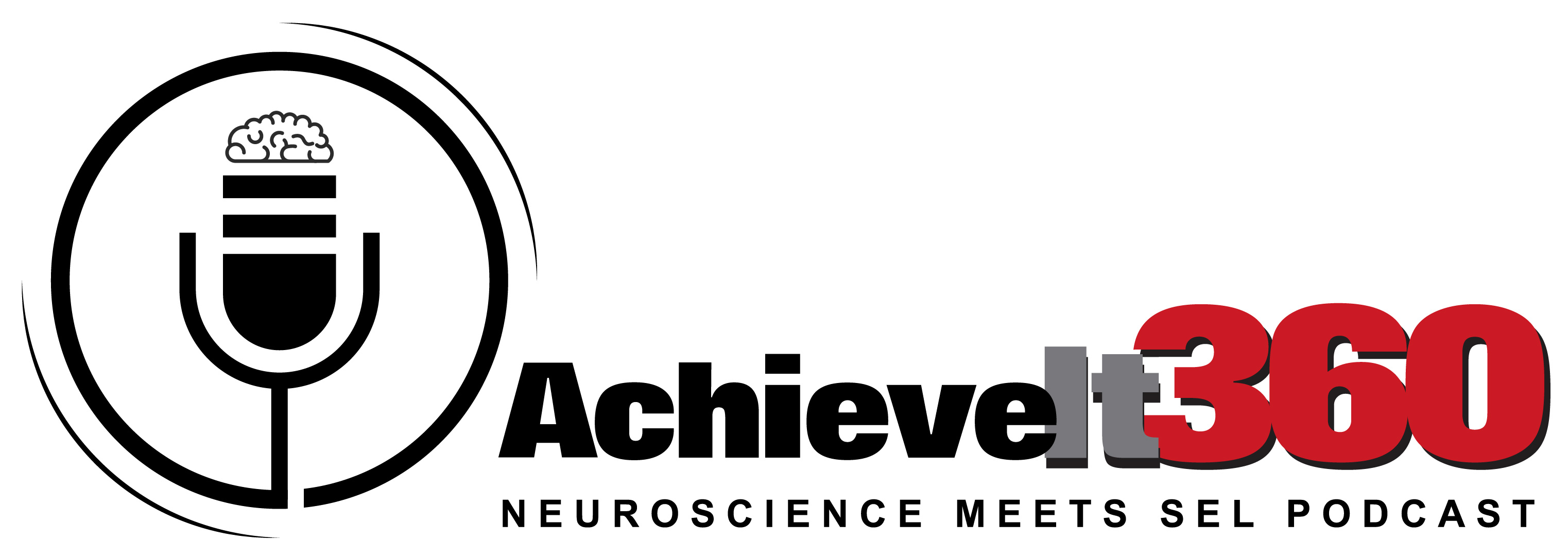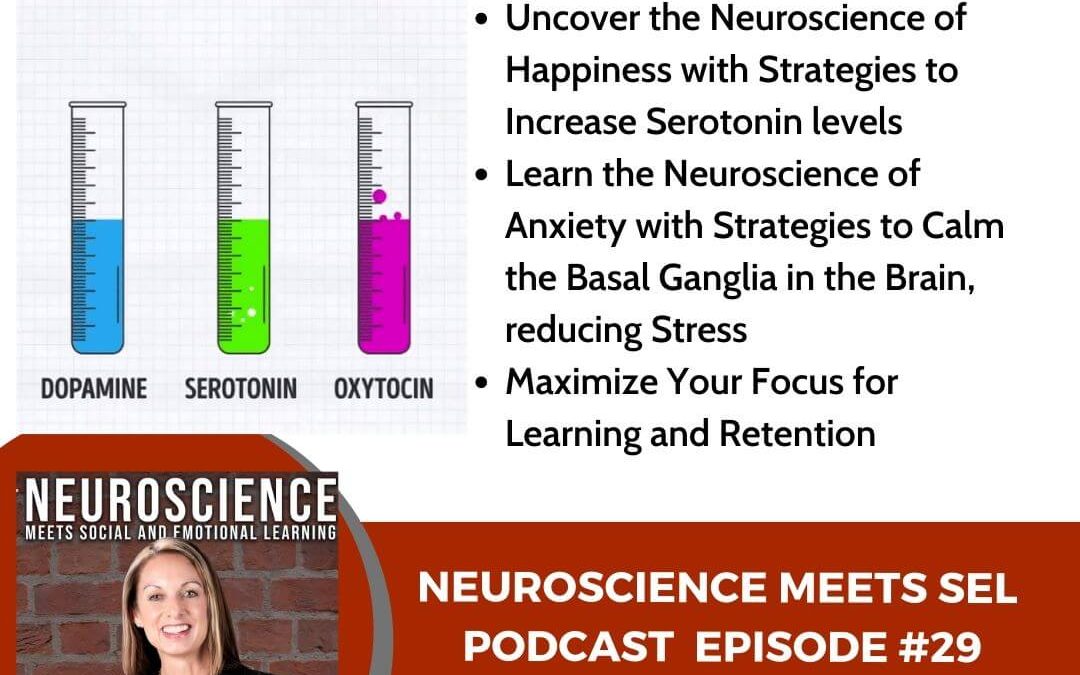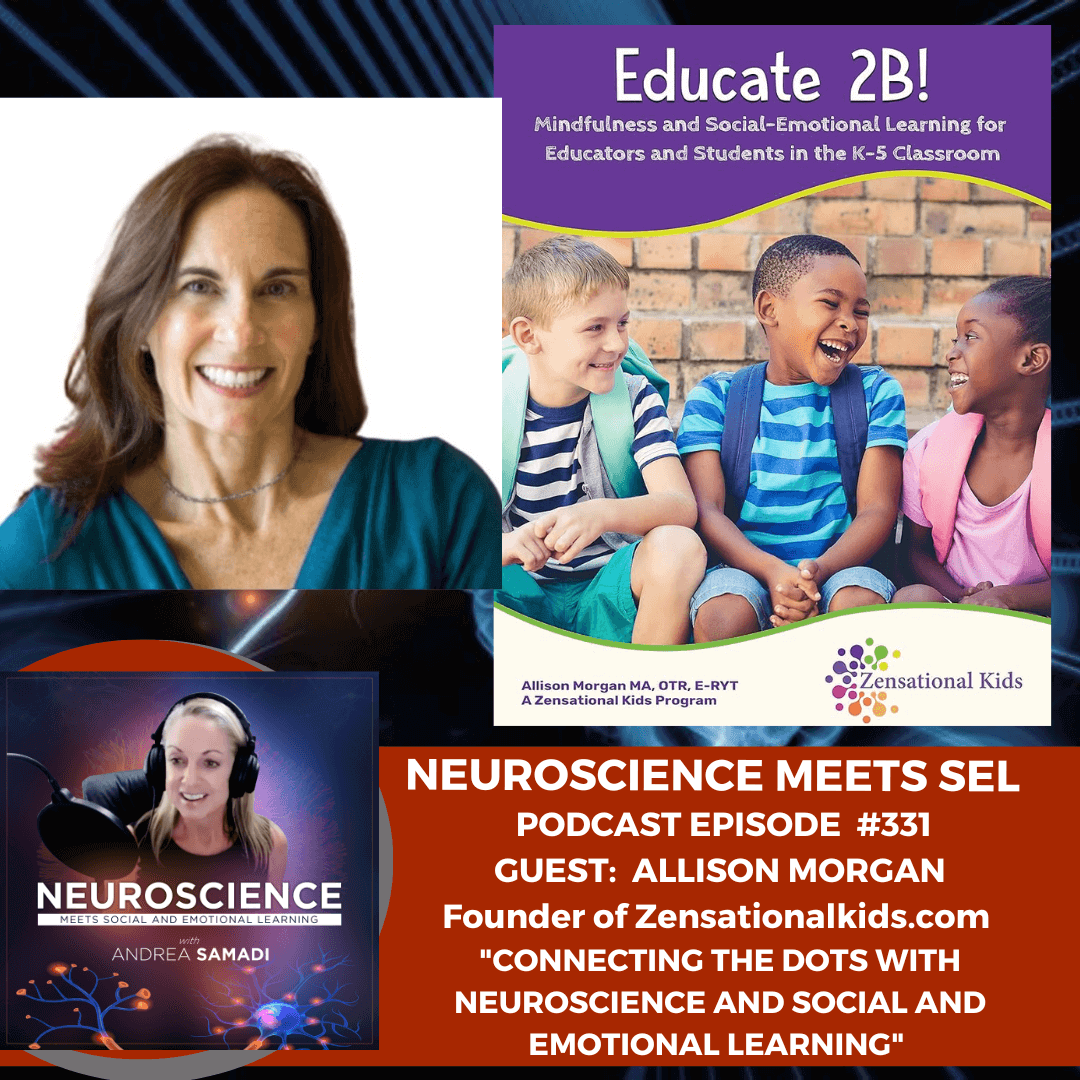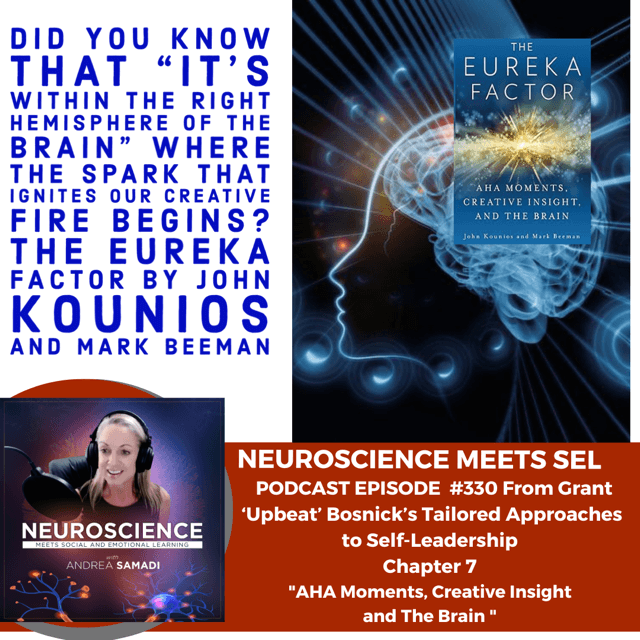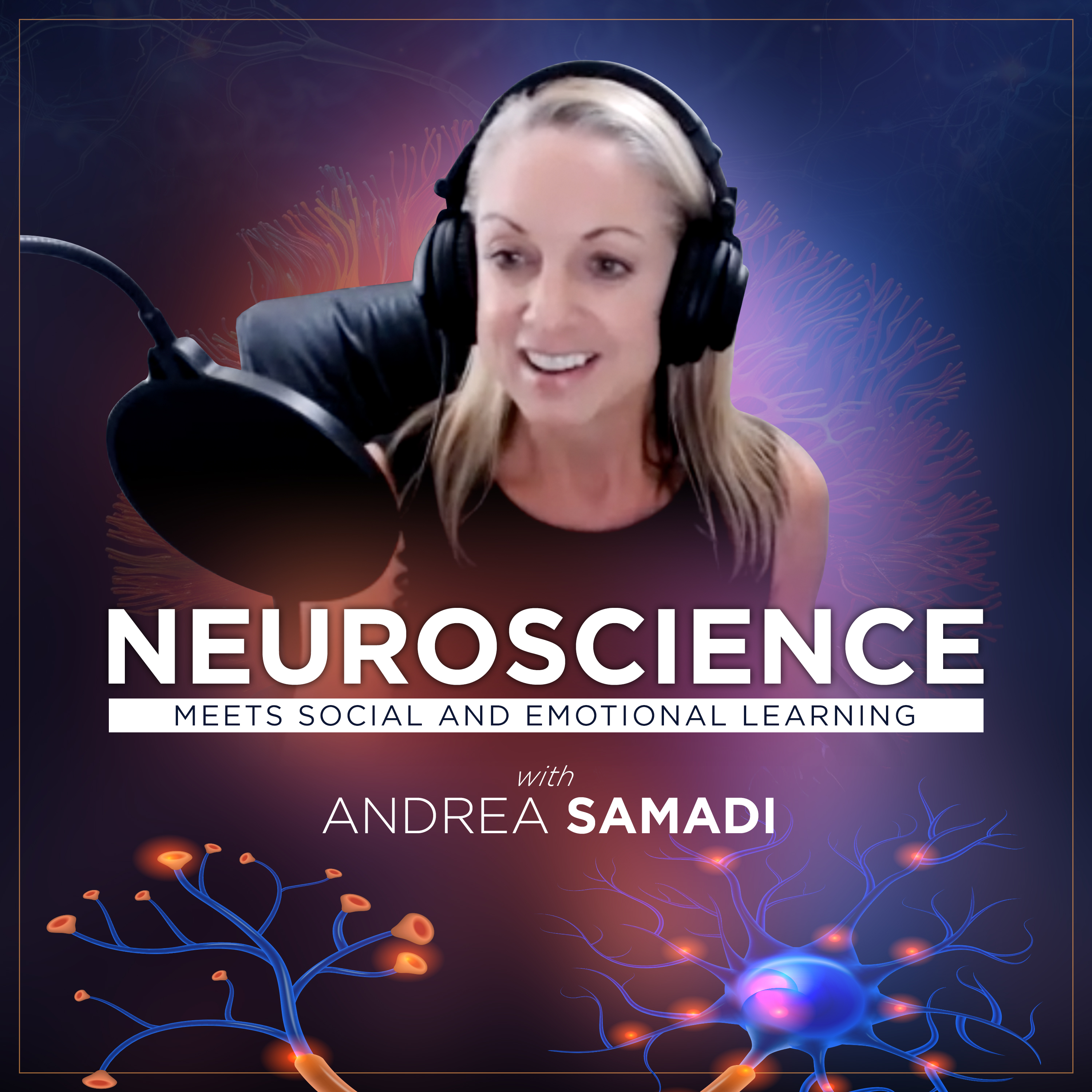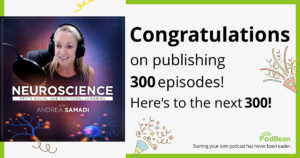Welcome to the “Neuroscience Meets SEL” podcast EPISODE #29, my name is Andrea Samadi, a former educator who has been fascinated with understanding the science behind high performance strategies in schools, sports and the workplace for the past 20 years. Let’s dive right into this topic on “How to Re-Wire Your Brain for Happiness and Well-Being to Optimize Learning.” You can watch this episode on YouTube for the visual effects for more impact and learning.
I’m sure most of us are aware that stress is the number one cause behind anxiety, depression, low energy, work burn-out, and cardiovascular disease[i], but do you know how stress impacts our brain? Did you know that:
-
- Chronic stress and depression causes measurable brain shrinkage?
-
- “51% of us will have a mental health issue (post-traumatic stress, obsessive-compulsive, personality, anxiety, addiction, or an eating disorder to name a few) at some point in their life”
- andthat 1/5 students struggle with depression, while ¼ struggle with anxiety which means we have reached epidemic levels with today’s youth.
And these shocking statistics impacts society with:
- Work burn-outAnxiety and DepressionCardiovascular DiseaseNeurological Disorders and eventually leading toDeath
Also Impacting our Students:
-
- A recent study
- shows that if the educator is stressed, the student will also be stressedStress is impacting our ability to learnStudent behavior was also impacted, contributing to more stress for educators
Dr. Daniel Amen, a psychiatrist and brain disorder specialist of the Amen Clinics[v] and the father of Chloe Amen from podcast #25 with “Strategies to Change Your Brain to Change Your Grades”[vi] explains that “if you struggle with attention, focus, sadness, anxiety, worry, flexibility, stubbornness, or impulsivity, welcome to the club—this is normal.”[vii] These days it is more normal to have a problem, than not have a problem. Most of us will have a mental health issue in our lifetime—and when it happens, we think that we are the only one and that no one else understands. Dr. Amen has a book coming out in March 3, 2020 called “The End of Mental Illness: How Neuroscience is Transforming Psychiatry and Helping Prevent or Reverse Mood and Anxiety Disorders, ADHD, Addictions, PTSD, Psychosis, Personality Disorders and More.”[viii] If left untreated, these brain disorders can have “serious personal, interpersonal, occupational and social consequences.”[ix]
In this podcast episode, we are going to look at the neuroscience of happiness, anxiety, stress, learning and retention with some ideas and strategies to naturally improve each area, so that we can get a handle on life’s largest challenges with an understanding of our brain chemistry. Our goal is to intentionally set ourselves up for success with this new level of awareness.
We will cover:
- A reminder of the recipe for peak performance (fun, fear, focus) from episode #27.What’s the neuroscience of happiness—and how to boost our serotonin levels to generate more happiness.What’s the neuroscience of anxiety (our body’s natural response to stress that can become a mental disorder when someone regularly feels unusually high levels of anxiety) and stress (which is our body’s response to a challenge or demand) with strategies to calm our limbic, emotional brain.What’s the neuroscience of learning and how can we be sure that our brain is primed to learn?
All of the answers to these questions can be found within the chemistry of our brain and with how active or hard certain parts of the brain are working. The best course I have taken to understand how my own brain is working is Dr. Amen’s Thrive by 25 Online Course[x] where he outlines some of the most common problems he sees within the brain with natural solutions to overcome each challenge. The most interesting fact I found was that diet and exercise were solutions to the most common brain problems he spoke about, (anxiety/depression/emotional issues) so if you are eating healthy, getting enough sleep, taking supplements and exercising, you are on the right track for preventing the most common brain problems.
Have you ever thought about your brain with regards to your work, learning, success or productivity? What about your happiness, personal life or relationships? “Your brain controls everything that you do, so when it works right, you work right.”[xi] It’s only been the past five years for me, where I’ve been learning about the importance of my brain and its health and I’m not surprised that the recent advances in neuroscience have led to an emerging field of educational neuroscience—bringing together researchers in cognitive neuroscience, educational psychology, and technology to create new programs for the classroom. Why not look at the application of these ideas for the workplace and our personal lives as well?
Mental health is something that society still doesn’t talk openly about. When I look at my personal family situation, with my 2 parents and 2 sisters and myself—my parents and both of my sisters struggled with depression at one point. You can add me to statistics as I didn’t figure out healthy eating habits until my late 20s when a doctor[xii] recommended I cut sugar out of my diet, (I’m talking about all sugar, including high glycemic fruits) and it completely transformed my life, cleaning up every health issue I had. Although our family didn’t talk about the importance of our mental health growing up, or the importance of diet and exercise (I remember begging my Dad to let me go running in an ice storm because exercise has always been my solution to improve well-being) my Mom taught us about the importance of using our mind to attain our goals. I’m sure no one was surprised when I decided to take move from Toronto (where half the year we dealt with dark, gloomy days and freezing weather) to the sunny, bright and warm climate in Arizona, with year round sunshine and vast mountains for daily exercise, –what research shows combats the most common brain problems. The environment you live in impacts your happiness, but if you don’t have the ability to pick up and move somewhere else, there are many other strategies you can incorporate to boost your mood, which is turn will boost your results. As a kid, I also wondered if helping my parents more with tidying the house would help offset some of their stress, but I know now, that there was much more involved with what was happening to them than just needing help with housework. Understanding the chemistry of our brain, and what brain type[xiii] we have is important, and then we can look for strategies to help promote our brain and body health for optimal results in our life.
NOTE: Look up and take Dr. Amen’s Brain Type Assessment[xiv] to get an idea of what type of brain you have. You will receive an email with a video explaining your brain type, characteristics of this type of brain, dietary suggestions for your specific brain type and a full report with your brain fit score. My Brain Fit Score was 82/100 and Brain Type 1 and I’m fully aware of the areas I can improve on. The dietary suggestions were also right on the mark for me. Awareness is the key so that we can take action for these improvements to occur. Try it out!
Remember the Neuroscience of Success: Dopamine, Noradrenaline, Acetyl Choline (Fun, Fear, and Focus)
In our podcast #27 with Friederike Fabritius, we covered the DNA of success or peak performance[xv] which is that brain state where we lose the presence of time and are the most productive. She mentioned the importance of having fun with your work, releasing the neurotransmitter dopamine, having just enough fear or a challenge to release the neurotransmitter noradrenaline and that with these two factors, focus will occur, and the neurotransmitter acetyl choline will be released. These three factors must be in place for peak performance to occur and when we hit this level of performance, it’s important that we are able to manage our distractions so that we can stay here for as long as possible for those higher levels of productivity.
Throughout the episodes on this podcast, I’ve been focused on finding those leaders who are doing important work in the field of social emotional learning and neuroscience—to show how these two emerging fields can impact our cognitive abilities. It’s clear that people are drawn to this work, not just in schools, but this understanding has implications in different areas of society like economics, law and security.[xvi] It’s interesting to see how understanding how our minds and brains work in addition to self-awareness is spreading around the world as more and more people are looking for solutions to life’s challenges from within. I also noticed that listeners to this podcast are increasing rapidly as we now are in over 42 countries. I do appreciate the feedback and support for these ideas, and it does help me to hear what you think as we move ahead. Each of these episodes are currently being transcribed and will be released as my next book.
What is the Neuroscience of Happiness? Increase Serotonin with that 5:1 Ratio of Positives to Negatives
We all want to experience happiness, and there is a neuroscience to happiness. Dr. Rick Hanson, a neuropsychologist and New York Times Best Selling author, is one of the leading experts in the neuroscience of happiness. In the 2019 Mindful Peace Summit, he opened his session by explaining that he got into the work of mindfulness and began searching for answers to the neuroscience of happiness because in his youth he “wondered why people were so unhappy, including himself. He wanted to be less lonely, and more proud of himself”[xvii] and recalled that most of his childhood consisted of feeling “less than” others so he grew up lacking confidence in himself. If we don’t get the acceptance we needed growing up, that will translate into an emptiness that lingers in your mindset and will impact our future performance. Dr. Hanson explains that if you want to be more confident, you must “embrace experiences that bring out your confidence.”[xviii] We see many young people, like the successful podcaster Lewis Howes,[xix] (Who does The School of Greatness Podcast)[xx] who were bullied as a kid, turn to boxing or wrestling as a way to fight back and gain this confidence back.
Dr. Hanson noticed in college that when he ignored how he was feeling, he just kept feeling bad about himself, but when he had a positive experience, and stayed with it, over time he was able to build more positive experiences than negative, building up his confidence. He explains that “neurons that fire together, wire together” and he was actually rewiring his brain from being insecure and negative, to confident and positive. We also know that you can “name it to tame it”[xxi] and when you are able to express what you are feeling, these feelings and emotions become manageable. There is also the negativity bias to be aware of where the brain must have at least a ratio of 5:1 positive to negative interactions so that the negative interaction won’t cause an impact. As parents, teachers, coaches and co-workers we must remember that when giving someone feedback, we must have at least five positive things to say to every one negative thing since “good experiences bounce off the brain like Teflon and bad experiences stick to the brain, like Velcro.”[xxii] Be sure to consciously focus on the positive experiences so you won’t let that one negative experience stick around, or it will impact your mindset and future results.
Remember: The brain has mood chemicals called neurotransmitters that are “chemical messengers sent into the synapse (of a neuron) by an electrical charge in the axon, released at the synaptic gap to communicate with dendrites of another neuron, impacted heavily by exercise, and nutrition. Levels of the different neurotransmitters have a profound effect on emotion, perception, memory, alertness, and energy.”[xxiii] If you are someone who enjoys intense exercise, you will notice the benefits of endorphins that are released in the brain and reduce our perception of pain. Researchers are still not sure what causes us to have chemical imbalances in the brain, when we don’t feel right, there are some things we can do to change the chemistry of our brain.
STRATEGIES TO INCREASE HAPPINESS and NATURUALLY INCREASE YOUR SEROTININ LEVELS
- Embrace experiences that bring out your confidence. Do you know what makes you happy? This takes self-awareness. Do you know what makes other people happy? Do you ask them? Learn more about other by saying “Hey, how’s it going today?” and listen to what they say. Taking this extra step will strengthen your relationship with your co-workers, friends or relationship.Remember the 5:1 negativity bias and say at least five positives to every one negative piece of feedback since good experiences bounce off the brain like Teflon and bad experiences stick to the brain like Velcro.
Remember that “neurons that fire together wire together,”[xxiv] so stay with the positive feelings more and eventually the negative ones will fade away since neurons that are out of psych, fail to link.
-
- Think of news ways to “generate”
-
- happiness and start practices that make you feel happier and better about yourself. It really is our responsibility to generate our own happiness. No one can do this for you.Diet and nutrition, supplements and exercise are also important to boost serotonin levels, increasing happiness naturally. You can take “saffron supplements, 5 HTP, exercise, eat low glycemic, healthy carbs (hummus/berries), and keep your gut healthy with probiotics.”
The Neuroscience of Anxiety: Calming the Basal Ganglia
Within our Limbic System, our emotional brain, is the Basal Ganglia that when revved high, makes us feel anxious. Do you know the difference between anxiety (our body’s natural response to stress that can become a mental disorder when someone regularly feels unusually high levels of anxiety) or stress (which is our body’s response to a challenge or demand)? Some anxiety is normal, and the same goes for stress.
We know there are 3 levels of stress response.
- POSITIVE: Brief increase in heart rate, mild elevations in stress hormone levels (what happens when we need to speak in front of a crowd, play a sport, take a test, or that nervous energy we feel before a job interview).TOLERABLE: Serious, temporary stress responses, buffered by supportive relationships. The key is to have support systems in place for this type of stress.TOXIC: Prolonged activation of stress response systems in the absence of protective relationships. This is the one we are most concerned about as this type of stress causes the most damage.
We must have strategies in place to help us to reduce anxiety and stress so that they don’t interfere with our day to day life.
STRAEGIES TO REDUCE ANXIETY AND STRESS
- Exercise, meditation and deep belly breathing to increase oxygen to the brain.Go for a walk outside-research shows that different brain regions are activated when you’re outside. Getting out into the sunshine increases the production of Vitamin D and serotonin—plus it just feels good. If you can’t go outside, look out a window.Zone out-let yourself do nothing for a while and just let your mind wander. Research shows that “creative incubation” happens during mind-wandering. You are more likely to problem-solve successfully if you let your mind wander and then come back to the challenge. Dr. Sriny Pillay writes about the power of the unfocused mind in his most recent book “Tinker, Dabble, Doodle, Try” where you sharpen your ability to think and get things done using your ability to make your mind wander. Flashes of insight and solutions to problems often show up at this time, but we must be willing to allow these breaks.Unplug from technology—silence is good for the brain.Mental imagery—warming images (like a cup of hot chocolate) if you are feeling stressed, or a place that makes you happy (the beach).Dietary supplements like fish oil, magnesium, l theanine (in green tea) and gabba supplements are known to help calm the brain.
The Neuroscience of Learning: Acetyl Choline, Dopamine, Serotonin, Noradrenaline
As far as learning, think about this:
- Why is it that I can forget some words I used to know in French (but haven’t practiced in a few years) but that I will never forget my 6th grade teacher, Mr. Walker, teaching me to play basketball, or doing math equations.Why is it easier for me to learn a second language at age 5 versus age 55?Why do I learn better after a good night’s sleep?Why is my creativity enhanced when I run up and down a mountain before I sit at my desk?
If there is a formula for peak performance, (Fun, Fear, Focus), a neuroscience to happiness and anxiety, then there must also be one for learning. Bruce McCandliss, professor in Stanford’s Graduate School of Education and the director of the Stanford Center for Mind, Brain and Computation, believes that brain-imaging technology is revolutionizing the study of educational experiences and their effect on the brain. These brain images are showing new insights in how children are learning to read. He talks about the fact that “when you focus your mind, you actually amplify the circuits in your brain that lead to learning and amplify information processing.”[xxvii] This is something we spoke to Dr. Daniel Siegel[xxviii] about (episode #28) with his “Wheel of Awareness” Meditation. When we are focusing intentionally on something (whether it’s our health, relationships, business or learning) we amplify the information processing and change the structure of the brain in this area. We actually re-wire the brain with the activity we are doing. Remember: Neurons that fire together, wire together and neurons that are out of psych, fail to link. Dr. Siegel mentioned that the research was there to show that this practice improves health in addition to many other benefits.
Let’s see if we can take our understanding to the next level with how neuroscience impacts the learning process so we can create more impactful lessons as an educator, thoughtful skill-building drills as a coach, or connect our employees to new ideas and information in an engaging and enjoyable manner.
STRATEGIES TO INCREASE LEARNING:
USE EMOTION AND FREQUENCY OF USE: To help memories stick and “motivation, cues, context and frequency of use can all affect how accurately you remember something.” [xxix] It’s the reason I remember my 6th grade teacher, and frequency of use is the reason I have forgotten most of the French words I used to know. When learning a new skill, how will you make it memorable?
FIND YOUR FOCUS: If you are a teacher who can creatively get your students to somehow “focus” on their work, you will be re-wiring their brain which will lead to learning. Whether it’s putting their finger under each word they read or using a pointer on their finger as they read, however you can get a student to focus on what they are learning, is where the magic happens. If you look at some of the most successful modern workplaces, you will find they have meditation and exercise rooms, dream walls to record vision and goals, plenty of relaxation areas, and of course, a place to grab a cup of tea, water or coffee. Think about starting meetings with a clear intention for the meeting to stay on track and focused on the outcome.
MORE HAPPINESS, JOY, LAUGHTER: The brain thrives with happiness, joy and laughter. The more we can create fun with our learning, we have seen with peak performance and flow states, we will be encouraging learning in a way that time will be lost. Remember that the recipe for peak performance includes fun!
Major Neurotransmitters that Impact Learning:
-
- Acetyl Choline – plays an important role in learning and memory.Dopamine – involved in conscious and emotional response and basis of the brain’s natural reward system, associated with positivity.Serotonin – brain balancer, involved in arousal, temperature regulation, sensory perception, regulates melatonin, involved in relaxing, mood, emotions, learning and memory, affected by exercise, eggs, lean meat contains L-tryptophan which helps make serotonin.Norepinephrine/noradrenaline – arousal, involved in fight or flight stress response, metabolic rate, blood pressure, and mood.
On our next episode with Mark Waldman, we will uncover new brain research documented in Mark’s new book Neurowisdom[xxxi] showing that relaxation, creativity, imagination and intuition are essential for learning and problem solving.
-
- Discover how your brain likes to learn (it will surprise you and has nothing to do with what you’ve experienced the classroom) 2. Find out why mind-wandering and daydreaming are essential for psychological health. Right in line with
- ’s book “Tinker, Dabble, Doodle, Try” that talks about the default network in the brain and the power of “unfocusing” your brain. Mark’s book “Neurowisdom” was the first book to talk about the default network mode and provides many practical examples for using your brain to improve finances, happiness and success. 3. Learn how Brain Network Theory is changing the world of neuroscience…and your health! 4. See what living neurons and networks actually look like.
If we can intentionally practice strategies that reduce our stress and anxiety, while increasing our happiness, we will be well on our way to retaining what we are learning. See you next week!
ADDITIONAL HELP SUGGESTIONS:
These suggestions have been compiled as I am researching these areas to offers ideas, strategies and suggestions to bring more awareness to the topics. Please do know that the ideas and strategies I’m sharing with you should not replace seeking professional help[xxxii] if needed.
[i] Chronic stress disrupts neural coherence between cortico-limbic structures João Filipe Oliveira, Nuno Sérgio Dias, Mariana Correia, Filipa Gama-Pereira, Vanessa Morais Sardinha, Ana Lima, Ana Filipa Oliveira, Luís Ricardo Jacinto, Daniela Silva Ferreira, Ana Maria Silva, Joana Santos Reis, João José Cerqueira, Nuno Sousa Front Neural Circuits. 2013; 7: 10. Published online 2013 Feb 6.
[ii] 72 Amazing Brain Facts (Deane Alban, January 2018). https://bebrainfit.com/human-brain-facts/?fbclid=IwAR0amQTdwOEAlsh_7gQ34RhvJDZefHiZFVYGG7O__hGyOwD_j7lJM0qYxDA
[iii] Brain Thrive by 25 Online Course by Dr. Daniel Amen https://www.amenclinics.com/blog/tag/brain-thrive-by-25/
[iv] “Social and Emotional Learning, Teacher Well-Being, and Student Success: What Do We Know? And Where do We Go From Here?” Webinar June 5th 2018 with Dr. Mark Greenber, Penn State and Dr. Kimberly A. Schonert-Reichl https://vimeo.com/275147739
[v] https://www.amenclinics.com/
[vi] 15-year-old Chloe Amen Reveals Strategies on how to “Change Your Brain, Change Your Grades” https://podcasts.apple.com/us/podcast/15-year-old-chloe-amen-reveals-strategies-on-how-to/id1469683141?i=1000446233385
[vii] ibid
[viii]Dr. Daniel Amen, March 3, 2020 The End of Mental Illness: How Neuroscience is Transforming Psychiatry and Helping Prevent or Reverse Mood and Anxiety Disorders, ADHD, Addictions, PTSD, Psychosis, Personality Disorders and More. https://www.amazon.com/End-Mental-Illness-Neuroscience-Transforming-ebook/dp/B07T6C3CWH/ref=tmm_kin_swatch_0?_encoding=UTF8&qid=1574362380&sr=8-3
[ix] https://www.amenclinics.com/spect-gallery/anxiety-depression/
[x] Brain Thrive by 25 Online Course by Dr. Daniel Amen https://www.amenclinics.com/blog/tag/brain-thrive-by-25/
[xi] Brain Thrive by 25 Online Course by Dr. Daniel Amen https://www.amenclinics.com/blog/tag/brain-thrive-by-25/
[xii] Dr. Richard Jacoby and Raquel Baldelomar “Sugar Crush” (Harper Wave, 2nd Edition April 2015) https://www.amazon.com/dp/B00KPVB4OA/ref=dp-kindle-redirect?_encoding=UTF8&btkr=1
[xiii] What’s Your Brain Type Quiz by Dr. Daniel Amen https://brainhealthassessment.com/
[xiv] What’s Your Brain Type Quiz by Dr. Daniel Amen https://brainhealthassessment.com/
[xv] Friederike Fabritius: “Fun, Fear, and Focus: The Neurochemical Recipe for Achieving Peak Performance” | Talks at Google Published Jan.15, 2019 https://www.youtube.com/watch?v=pWi-oCySuFA
[xvi] Educational Neuroscience Michael Thomas Published July 5, 2018 https://www.youtube.com/watch?v=2uK3d9hL-IQ
[xvii] 2019 Mindful Kids Peace Summit https://www.mindfulkidspeacesummit.com/first-page
[xviii] Rick Hanson “Hardwiring Happiness” YouTube Published Nov. 7, 2013 TEDx Marin 2013 https://www.youtube.com/watch?v=jpuDyGgIeh0
[xx]Lewis Howes School of Greatness Podcast https://podcasts.apple.com/us/podcast/the-school-of-greatness/id596047499
[xxi] Dr. Dan Siegel “Name it to Tame it” YouTube Published Dec. 8th, 2014 https://www.youtube.com/watch?v=ZcDLzppD4Jc
[xxii] Rick Hanson “Hardwiring Happiness” YouTube Published Nov. 7, 2013 TEDx Marin 2013 https://www.youtube.com/watch?v=jpuDyGgIeh0
[xxiii] Neurotransmitters and Learning by Joseph Georgic April 22, 2015 https://www.hastac.org/blogs/joegeorgic/2015/04/22/neurotransmitters-and-learning
[xxiv] “Neurons that Fire Together, Wire Together, So Simple” by Andrea Samadi on LinkedIn published Nov. 17, 2016 https://achieveit360.com/neurons-that-fire-together-wire-together/
[xxv] Brendon Burchard “The Secret to Happiness” https://brendon.com/blog/the-secret-to-happiness/
[xxvi] Brain Thrive by 25 Online Course by Dr. Daniel Amen https://www.amenclinics.com/blog/tag/brain-thrive-by-25/ (Lesson 4 Cingulate and Cognitive Flexibility).
[xxvii] Bruce McCandliss “The Neuroscience of Learning: Thinking Big About Learning” YouTube Published Nov. 3, 2015 https://www.youtube.com/watch?v=5_6fezBz9IA
[xxviii] Dr. Daniel Siegel on “Mindsight: The Basis for Social and Emotional Intelligence” https://podcasts.apple.com/us/podcast/clinical-professor-psychiatry-at-ucla-school-medicine/id1469683141?i=1000456048761
[xxix] 72 Amazing Brain Facts by Deane Alban https://bebrainfit.com/human-brain-facts/
[xxx] Lizzy Brown Learning on the Move: Brain Parts and Neurotransmitters https://www.learningonthemove.org/brain-parts–neurotransmitters.html
[xxxi] Neurowisdom: The New Brain Science of Money, Happiness and Success by Mark Robert Waldman and Chris Manning PhD. (Jan.31, 2017). https://www.amazon.com/dp/B01N9BLBDH/ref=dp-kindle-redirect?_encoding=UTF8&btkr=1
[xxxii] https://www.nimh.nih.gov/health/find-help/index.shtml
Podcast: Play in new window | Download
Subscribe: Apple Podcasts | RSS
